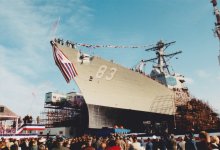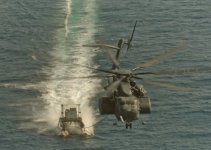U.S. Navy's Small Ship Troubles
- Thread starter mso489
- Start date
You are using an out of date browser. It may not display this or other websites correctly.
You should upgrade or use an alternative browser.
You should upgrade or use an alternative browser.
SmokingPipes.com Updates
Watch for Updates Twice a Week
These ships have an interesting and hopefully instructive history. They were conceived from a concept developed by the Navy War College, called "Streetfighter." Streetfighter was a relatively small ship envisioned to tackle maritime warfare in constrained and shallow waters (think around island chains) -- the littorals. The idea soon gained a lot of support and like most ideas, it started to grow, both in cost and size. The CNO also wanted to make a point that defense acquisition rules and regulations were unnecessarily cumbersome and sold the idea that many of the usual steps could be skipped entirely. This opened the way to incorporate every new idea, many of which had never been tried before, into the design and operation. This included minimal manning, multiple crews, warfare modules, etc. Contracts were signed with two different shipbuilders, who were advocating radically different hull designs. The idea was to buy a few of both designs the select a "winner" to fill out an envisioned fleet of about 60 ships.
The Navy ended up with a ship that was almost as large as a Perry Class Frigate, but with less firepower and less on-station capability, though it could go very fast (albeit not for very long). It was not a multi-mission ship as it had to have special mission modules loaded, there was for example an Anti-Submarine Mission Module set. Module exchange took a number of days and included a few extra specially trained sailors to embark with the equipment. Mission modules suffered from their own development and cost issues. The approach's shortcomings were quickly demonstrated in war games.
Volumes have been written about the LCS program, known to some in the Pentagon as the "Little Crappy Ship." Poor operational performance, increasing costs (rising to >$600M/hull, originally projected at <$200M), and a shift of emphasis from littoral warfare back to blue water. LCS was particularly ill-suited to blue water warfare. Eventually, the Sec of Def told the Navy to downsize the program significantly.
For comparison, a McCain Class DDG now costs in the neighborhood of $3.5B.
The Navy ended up with a ship that was almost as large as a Perry Class Frigate, but with less firepower and less on-station capability, though it could go very fast (albeit not for very long). It was not a multi-mission ship as it had to have special mission modules loaded, there was for example an Anti-Submarine Mission Module set. Module exchange took a number of days and included a few extra specially trained sailors to embark with the equipment. Mission modules suffered from their own development and cost issues. The approach's shortcomings were quickly demonstrated in war games.
Volumes have been written about the LCS program, known to some in the Pentagon as the "Little Crappy Ship." Poor operational performance, increasing costs (rising to >$600M/hull, originally projected at <$200M), and a shift of emphasis from littoral warfare back to blue water. LCS was particularly ill-suited to blue water warfare. Eventually, the Sec of Def told the Navy to downsize the program significantly.
For comparison, a McCain Class DDG now costs in the neighborhood of $3.5B.
They were both mistakes, though for different reasons.This thread took a weird turn. I thought we were talking about boats. To keep it on rails: What was a bigger blunder the LCS program or the Zumwalt program?
Destroyers cost about a billion.
My grandfather was a Tin Can Sailor and saw action in both theaters in WW2- two German Subs and a lot of splashed planes. The HMS Holcomb was running port-quarter when she took a torpedo, showed her keel and disappeared, ash cans engaging at their set depths. My grandfather said they were pulling English sailors from the water “bleeding from every port.” My hats off to the sea legs of these old time Destroyer men. MSO- Thank you for your service. Your father’s as well.
First, let me correct my statement above. The current cost of a destroyer is now about 2.2 billion dollars, not one billion.My grandfather was a Tin Can Sailor and saw action in both theaters in WW2- two German Subs and a lot of splashed planes. The HMS Holcomb was running port-quarter when she took a torpedo, showed her keel and disappeared, ash cans engaging at their set depths. My grandfather said they were pulling English sailors from the water “bleeding from every port.” My hats off to the sea legs of these old time Destroyer men. MSO- Thank you for your service. Your father’s as well.
Back when we lived in Maine, my wife worked at the Bath Iron Works shipyard. She went from being a social worker to a manufacturer of weapons of mass destruction. At that time the original Arleigh Burks were under a billion.


Last edited:
As we learn in basic training, never forget your equipment is made by the lowest bidder.
Gone are the days of iron men and wooden ships. Now it’s the other way around.
Maybe but the spec is so high that our gear is still really good. I used to marvel at how indestructible all the stuff I was issued was. As a kid I would blow out the kneecaps on my blue jeans rather easily. Amazingly, BDUs just never tore despite all the abuse they received. A rucksack is more indestructible than any Northface pack I’ve ever owned.As we learn in basic training, never forget your equipment is made by the lowest bidder.
I'm also surprised the Navy haven't foisted them on the Coast Guard yet and thump their chest and say, "See! We support the Coast Guard!" Like they have done in the past. My first unit was a Wind class icebreaker that was commissioned around 1944 and given to the Russians. Russia got it stuck in the arctic, abandoned it and told the Navy they could have it back. The Navy transferred all the icebreakers to the Coast Guard. I was on it from 72-74.I'm surprised they haven't transferred them to the Coast Guard yet... That's what they seem to do with all the other junk the Navy didn't want when I was in.
Seriously though, shipbuilding has been an issue as of late in both the Navy & the Coast Guard.
Several years ago I remember the Coast Guard trying to save money by lengthening the 110' coastal patrol cutters by adding 13' feet to them. When I saw the prints, I pointed out what I believed were some design flaws. I wasn't listened to because I wasn't an engineer. The program was a disaster and a couple of the cutters broke in two... exactly as I stated, but what the hell did I know?
I remember that disaster of the 110s extension program but that was about six or seven years after I retired.
I suspect the LCS are too expensive to operate and maintain to re-assign them to the Coast Guard or as Naval Reserve vessels. The better of the two versions might linger in the fleet for acceptable assignments.
This harkens back to the mythology (some true) of Hymen Rickover, a renegade admiral who commandeered development of the nuclear powered submarine by building a working model in the dessert in the U.S. That way all the dangers and mistakes could be worked through before anything was launched as a commissioned sub.
He was an abusive boss, making junior officers wait for hours or days outside his office to interview for jobs in his program, including future president Jimmy Carter. But because he got the submarine design right, or whipped others into doing so, he is lionized in the nuclear Navy.
He tried to board a ship in civilian clothes without presenting an i.d. at the gangplank and a young sailor threatened him with his sidearm, and after establishing who he was, he went on to commend the sailor for taking his security duties seriously. Rickover was known for tooling about his commands in a VW bug.
This harkens back to the mythology (some true) of Hymen Rickover, a renegade admiral who commandeered development of the nuclear powered submarine by building a working model in the dessert in the U.S. That way all the dangers and mistakes could be worked through before anything was launched as a commissioned sub.
He was an abusive boss, making junior officers wait for hours or days outside his office to interview for jobs in his program, including future president Jimmy Carter. But because he got the submarine design right, or whipped others into doing so, he is lionized in the nuclear Navy.
He tried to board a ship in civilian clothes without presenting an i.d. at the gangplank and a young sailor threatened him with his sidearm, and after establishing who he was, he went on to commend the sailor for taking his security duties seriously. Rickover was known for tooling about his commands in a VW bug.
He promised Congress that the Nautilus would function for 25 years. For the last five or so it was held together with glue and scotch tape.
From your lips to God's ears.Maybe they'll decom the Independence and strike it, then they can give the name to more worthy Vessel.
Build ships. Scrap them or get ‘em sunk. Get more contracts. Build more ships.
Terrific business plan for ‘defense’ contractors.
(Not so great if you’re a sailor on one of the sunk ones.)
Terrific business plan for ‘defense’ contractors.
(Not so great if you’re a sailor on one of the sunk ones.)
The obvious solution is to send them to Ukraine. After stuffing them full of dollars, of course.
This reminds me that I need to research military contractor mutual funds. As I understand it, the services can't conduct meaningful audits because they don't keep receipts. Blank checks like those have got to mean unlimited profits right?The U.S. Navy has run into trouble with some of its most recently launched small ships. Built by two different major contractors, these are classified as littoral combat ships designed for coastal shallow-water duty. The Navy wants to decommission eight of ten of the current class for serious problems with propulsion systems and the lack of suitability for current needs, facing the Chinese deep water fleet rather than the small boat conflicts in the Middle East. These U.S. ships average only four years old.
Being a former enlisted minesweeper sailor aboard an Aggressive-class minesweeper in the South China Sea, a predecessor to the littoral combat ships -- and the son of a WWII YMS-class minesweeper skipper in World War II -- I've followed this new ship design closely and with great interest. I'll spare the pipe group all of the details. But it has been an interesting misstep in design and seagoing operations. The Congress doesn't want the Navy to abandon the ships, partly because of the investment already made, an partly because of the interest groups in the various states where these ships and their equipment are designed and built.
As a historical reference, the ship designing and building competition between navies goes back to the Greeks and Trojans and before. The European sea powers in the 18th and 19th Century were always jockeying between huge flagships with mighty arrays of guns to smaller, swifter and more maneuverable ships that could take shots at sinking the big ones. So this drama is not new. But it is riveting to people who've been aboard warships as crew and can sense the at-sea challenges that are, or are not met.
Last edited:
I had the opportunity to be interviewed by Rickover back in 1977. An unpleasant experience but it only lasted ~ 1 minute, that was the beginning of a 28-year career in submarines. Irascible as he seemed it's said that his staff was devoted and liked working for him; standards were high and fools not tolerated. The record of success and safety speaks for itself.This harkens back to the mythology (some true) of Hymen Rickover, a renegade admiral who commandeered development of the nuclear powered submarine by building a working model in the dessert in the U.S. That way all the dangers and mistakes could be worked through before anything was launched as a commissioned sub.
He was an abusive boss, making junior officers wait for hours or days outside his office to interview for jobs in his program, including future president Jimmy Carter. But because he got the submarine design right, or whipped others into doing so, he is lionized in the nuclear Navy.
He tried to board a ship in civilian clothes without presenting an i.d. at the gangplank and a young sailor threatened him with his sidearm, and after establishing who he was, he went on to commend the sailor for taking his security duties seriously. Rickover was known for tooling about his commands in a VW bug.
Wow, a "visitation" with the Admiral himself. That was a real vote of confidence that it was a short interview. He must have liked the cut of your jib. Years after my service in the Navy, I happened to field a phone call from Admiral Zumwalt who by then was much involved with activism around Agent Orange. That was an interesting moment. His years as the Chief of Naval Operations was fraught, but he handled some aspects pretty well.








